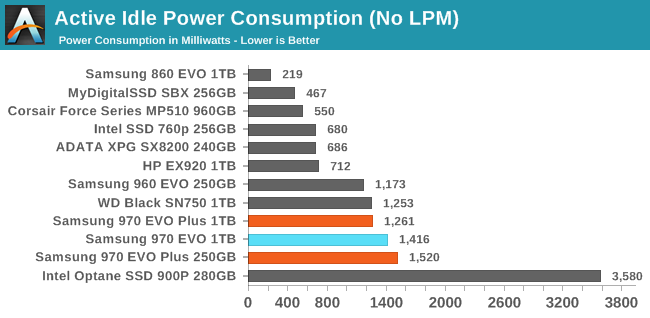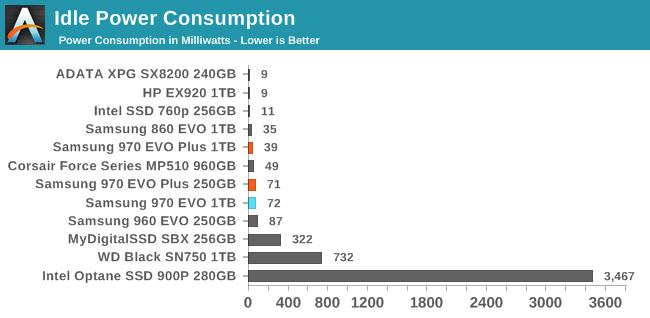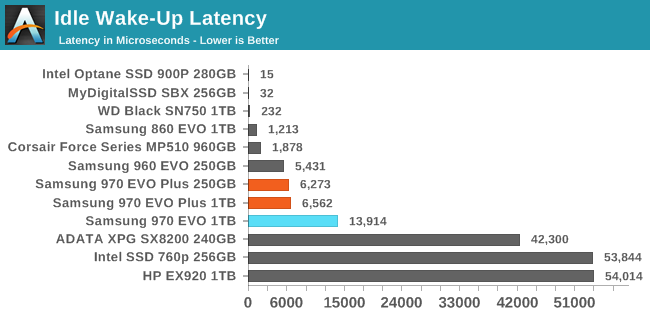The Samsung 970 EVO Plus (250GB, 1TB) NVMe SSD Review: 92-Layer 3D NAND
by Billy Tallis on January 22, 2019 10:00 AM ESTPower Management Features
Real-world client storage workloads leave SSDs idle most of the time, so the active power measurements presented earlier in this review only account for a small part of what determines a drive's suitability for battery-powered use. Especially under light use, the power efficiency of a SSD is determined mostly be how well it can save power when idle.
For many NVMe SSDs, the closely related matter of thermal management can also be important. M.2 SSDs can concentrate a lot of power in a very small space. They may also be used in locations with high ambient temperatures and poor cooling, such as tucked under a GPU on a desktop motherboard, or in a poorly-ventilated notebook.
| Samsung 970 EVO Plus NVMe Power and Thermal Management Features |
|||
| Controller | Samsung Phoenix | ||
| Firmware | 1B2QEXM7 | ||
| NVMe Version |
Feature | Status | |
| 1.0 | Number of operational (active) power states | 3 | |
| 1.1 | Number of non-operational (idle) power states | 2 | |
| Autonomous Power State Transition (APST) | Supported | ||
| 1.2 | Warning Temperature | 85 °C | |
| Critical Temperature | 85 °C | ||
| 1.3 | Host Controlled Thermal Management | Supported | |
| Non-Operational Power State Permissive Mode | Not Supported | ||
The Samsung 970 EVO Plus doesn't bring any changes to the power or thermal management features supported by the 970 EVO, but the declared power limits for each power state have been increased, with the full-performance PS0 state now allowing for up to 7.8W compared to 6.2W for the original 970 EVO.
| Samsung 970 EVO Plus NVMe Power States |
|||||
| Controller | Samsung Phoenix | ||||
| Firmware | 1B2QEXM7 | ||||
| Power State |
Maximum Power |
Active/Idle | Entry Latency |
Exit Latency |
|
| PS 0 | 7.8 W | Active | - | - | |
| PS 1 | 6.0 W | Active | - | - | |
| PS 2 | 3.4 W | Active | - | - | |
| PS 3 | 70 mW | Idle | 0.21 ms | 1.2 ms | |
| PS 4 | 10 mW | Idle | 2 ms | 8 ms | |
Note that the above tables reflect only the information provided by the drive to the OS. The power and latency numbers are often very conservative estimates, but they are what the OS uses to determine which idle states to use and how long to wait before dropping to a deeper idle state.
Idle Power Measurement
SATA SSDs are tested with SATA link power management disabled to measure their active idle power draw, and with it enabled for the deeper idle power consumption score and the idle wake-up latency test. Our testbed, like any ordinary desktop system, cannot trigger the deepest DevSleep idle state.
Idle power management for NVMe SSDs is far more complicated than for SATA SSDs. NVMe SSDs can support several different idle power states, and through the Autonomous Power State Transition (APST) feature the operating system can set a drive's policy for when to drop down to a lower power state. There is typically a tradeoff in that lower-power states take longer to enter and wake up from, so the choice about what power states to use may differ for desktop and notebooks.
We report two idle power measurements. Active idle is representative of a typical desktop, where none of the advanced PCIe link or NVMe power saving features are enabled and the drive is immediately ready to process new commands. The idle power consumption metric is measured with PCIe Active State Power Management L1.2 state enabled and NVMe APST enabled if supported.


The 970 EVO Plus brings modest improvements to both active idle and deep idle power consumption, likely due to the reduced voltage of the Toggle DDR 4.0 interface between the controller and the new 96L 3D NAND. However, the 970 EVO Plus is still a fairly power-hungry drive when its sleep states are disabled.

The idle wake-up latency of the 970 EVO Plus is about half that of the original 970 EVO. The 970 EVO Plus is now almost an order of magnitude faster to wake up than the Silicon Motion SM2262-based drives, but the Phison E12 controller used in the Corsair MP510 provides good power management and wakes up several times faster than Samsung's NVMe drives.










35 Comments
View All Comments
Chaitanya - Tuesday, January 22, 2019 - link
Quite a minor upgrade over previous drive.jeremyshaw - Tuesday, January 22, 2019 - link
Hence the name.Billy Tallis - Tuesday, January 22, 2019 - link
More substantial than the WD Black SN750.I don't think we'll see any more big jumps until PCIe 4.0 ships. Pretty much everybody has caught up on the NAND side, and most of the controller vendors have had decent NVMe controllers out for a while. There's no low-hanging fruit like there was when companies were still trying to make SM2260 or Phison E7 compete against Samsung with inferior NAND.
DanNeely - Tuesday, January 22, 2019 - link
More to the point it is a consistent incremental improvement. There've been far too many cases over the years when a v.next drive was an incremental improvement in manufacturing cost, that regressed in most to all performance numbers.boozed - Tuesday, January 22, 2019 - link
I call those performance improvements significant (just).Flunk - Thursday, January 24, 2019 - link
I don't think it's enough to elevate this drive over the high-end Silicon Motion drives in real-world uses. Not for consumers at least.nectrone - Thursday, January 24, 2019 - link
96-layer nand is an improvement on production speed, yields, and manufacturing cost, rather than perf. And tbh, we don't need better perf at all, or maybe a bit in 4k random, because 150MBps is a bit low in 2019. Instead, what we need, is prices to drop, below twice the price of an hdd of the same capacity.In 2018, 1TB tlc nvme 64-layer ssd was 10 times the price of an hdd, now in Jan it's 5 times. Sata 64-layer ssd were 7 times the price of hdd, now it's 3. I'd like TLC nvme to cost twice an hdd, and sata tlc to be the same price as an hdd. With 96-layer, we'll get closer to that.
haukionkannel - Tuesday, January 22, 2019 - link
Pity that the consumer version does not get 4.0 this year... I was hoping to have 4.0 compatible ssd when AMD 570x boards comes out. Well most like with my usage even these Are fast enough and I am not going to be Bottle negged by 3.0.sorten - Wednesday, January 23, 2019 - link
I had the same reaction. I'm running an old gaming PC and I'm ready to switch to AMD with a full set of upgrades at the end of the year and was hoping for PCIE 4.0, but my SSD is so old that I know any drive will be a huge improvement.ikjadoon - Tuesday, January 22, 2019 - link
Meta: has the scrolling video ad been moved to the right? It finally doesn't cover up the article when you scroll. Huge thank you.970 EVO Plus: I'm excited for this to get added to the SSD 2018 Bench. Curious how close it matches the 970 PRO 512GB, now at $170. My almost-full 250GB 960 EVO needs a capacity increase and $40 isn't a big difference for a minimum two-year purchase.